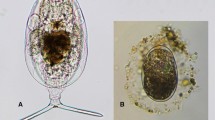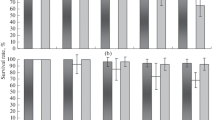Abstract
During a preliminary set of experiments (April 1987). I measured short-term (20 d) reproductive responses of laboratory-cultured Capitella sp. 1 at 20°C, at four daily ration levels (0.26 to 2.60 mg of organic nitrogen per bowl), and for four food types: Gerber's mixed cereals, Ulva sp., diatoms, and Tetramen fish food. Average female body size, number of fertile segments, and fecundity were significantly affected both by food type and food ration. Average fecundities ranged from 21 (Gerber, 0.26 mg N d-1) to 448.3 eggs per female (Tetramen, 2.60 mg N d-1). During a second set of experiments (May 1987), I measured the reproductive response of laboratory-cultured Capitella sp. 1 at 20°C at six ration levels of spring and summer sediment-trap material collected in the Patuxent Estuary, Maryland, USA. Worms raised on these two diets failed to reproduce during the period of this experiment. I used simple and miltiple linear-regression models to describe relationships between fecundity and daily rations and macro- (dry wt, C, N) and micronutrients (essential amino- and essential fatty acids). These models were carried out on three data sets corresponding to either 4 or 6 food types. The results suggest that different nutritional factors may be limiting for different foods. However micronutrients and especially essential amino acids probably more aptly describe nutritional limitation of reproduction in Capitella sp. 1.
Similar content being viewed by others
References
Adams SM, Angelovic JW (1970) Assimilation of detritus and its associated bacteria by three species of estuarine animals. Chesapeake Sci. 12:249–254
Amouroux JM, Grémare A, Amouroux J (1989) Modelling the ingestion and absorption of Abra alba (Mollusca: Bivalvia). Mar Ecol Prog Ser 51:87–97
Calow P (1975) The feeding strategies of two freshwater gastropods, Ancylus fluviatilis Müll. and Planorbis contortus Linn. (Pulmonata), in terms of ingestion rates and absorption efficiencies. Oecologia 20:33–49
Grassle JP, Grassle JF (1976) Sibling species in the marine pollution indicator Capitella. Science, NY 32:253–284
Grémare A, Marsh AG, Tenore, KR (1988) Short-term reproductive responses of Capitella sp. 1 (Annelida, Polychaeta) fed on different diets. J exp mar Biol Ecol 123:147–162
Grémare A, Marsh AG, Tenore KR (1989a). Fecundity and energy partitioning in Capitella capitata type I (Annelida: Polychaeta). Mar Biol 100:365–371
Grémare A, Marsh AG, Genore KR (1989b) Secondary production and reproduction of Capitella capitata (type I) (Annelida, Polychaeta) in relation to available resources during a population cycle. Mar Ecol Prog Ser 51:99–105
Hargrave BT (1970) The utilization of benthic microflora by Hyalella atzeca (Amphipoda). J Anim Ecol 39:427–437
Kemp PF (1986) Direct uptake of detrital carbon by the deposit-feeding polychaete Euzonus mucronata (Treadwell). J exp mar Biol Ecol 99:49–61
Langdon CJ, Levine DM, Jones DA (1986) Microparticulate feeds for marine suspension feeders. J Microencapsulation 2:1–16
Levin LA (1986) Effects of enrichment on reproduction in the opportunistic polychaete Streblospio benedicti (Webster): a mesocosm study. Biol Bull mar biol Lab, Woods Hole 171:143–160
Levin LA, Creed EL (1986) Effect of temperature and food availability on reproductive responses of Streblospio benedicti (Polychaeta: Spionidae) with planktotrophic or lecithotrophic development. Mar Biol 92:103–113
Lopez GR, Levinton JS (1987) Ecology of deposit-feeding animals in marine sediments. Q Rev Biol 62:235–259
Marsh AG (1988) Seasonal dynamics of a mesohaline, soft-bottom benthic community: secondary production, sedimentation, predation, and nutrition. PhD dissertation. University of Maryland, Solomons
Marsh AG, Grémare A, Tenore KR (1989) Effect of food type and ration of growth of juvenile Capitella sp. 1 (Annelida: Polychaeta): macro- and micronutrients. Mar Biol 102:519–527
Marsh AG, Harvey HR, Grémare A, Tenore KR (1990) Dietary effects on oocyte yolk-composition in Capitella sp. 1 (Annelida: Polychaeta): fatty acids and sterols. Mar Biol 106:369–374
Marsh AG, Tenore KR (1990) The role of nutrition in regulating the population dynamics of opportunistic, surface deposit-feeders in a mesohalyne community. Limnol Oceanogr 35:406–420
Newell RC (1965) The role of detritus in the nutrition of two marine deposit-feeders, the prosobranch Hydrobia ulvae and the bivalve Macoma balthica. Proc zool Soc Lond 14:25–45
Phillips NW (1984) Roles of different microbes and substrates as potential suppliers of specific essential nutrients to marine detritivores. Bull mar Sci 12:33–47
Rice DL (1982) The detritus nitrogen problem: new observations and perspectives from organic geochemistry. Mar Ecol Prog Ser 9: 153–162
Sokal RR, Rohlf FJ (1981) Biometry. The principles and practice of statistics in biological research. 2nd ed. WH Freeman & Co. New York
Tenore KR (1981) Organic nitrogen and caloric content of detritus. I. Utilization by the deposit-feeding polychaete Capitella capitata. Estuar, cstl Shelf Sci 12:39–47
Tenore KR (1983) Organic nitrogen and caloric content of detritus. III. Effects on growth of a deposit-feeding polychaete Capitella capitata. Estuar, cstl Shelf Sci 17:733–742
Tenore KR (1988) Nitrogen in benthic food chains. In: Sorensen E, Blackburn TH (eds) Nitrogen cycling in marine environment. J Wiley & Sons, London, p 191–206
Wible JG (1984) The effects of salinity, temperature, and food on the growth and reproductive output of Polydora nuchalis Woodwick, 1953 (polychaeta: Spionidae), PhD dissertation. University of Southern California, Los Angeles
Zajac RN (1986) The effects of intra-specific density and food supply on growth and reproduction in an infaunal polychaete, Polydora ligni Webster. J mar Res 44:339–359
Author information
Authors and Affiliations
Additional information
Communicated by J.M. Pérès, Marseille
Rights and permissions
About this article
Cite this article
Grémare, A. What describes fecundity of Capitella sp. 1 better: macro- or micronutrient availability?. Marine Bioliogy 119, 367–374 (1994). https://doi.org/10.1007/BF00347533
Received:
Accepted:
Issue Date:
DOI: https://doi.org/10.1007/BF00347533




